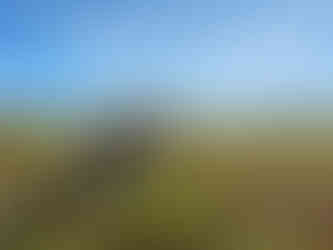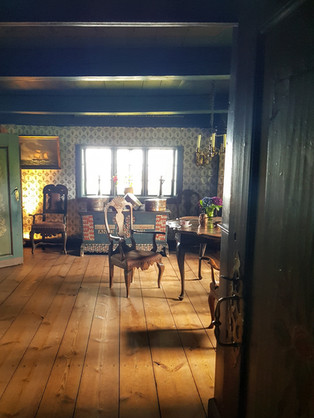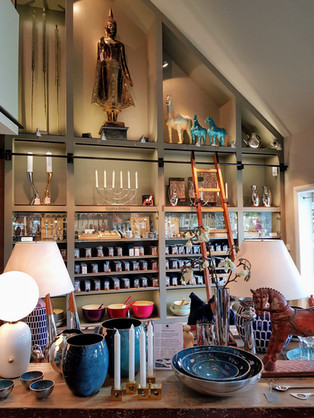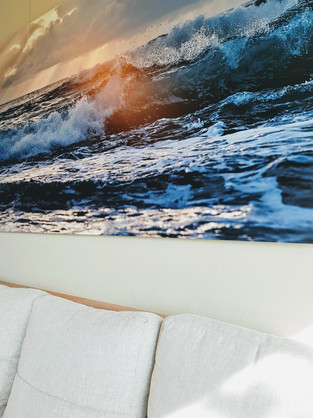Travelling back in time on e-bikes
- Alexandra Schüller

- Sep 28, 2020
- 4 min read
Updated: Nov 23, 2021
Authentic lifestyle and home decoration are shaped by nature, scenery and history. I’d like to understand Sylt’s origins and have decided to cycle across hilly bike paths (with a bit of battery support).


Past the bewitchingly beautiful purple blooming heathland, towards the Morsum cliff in the east of the island.
It is the end of August. One of the most popular months for tourists to visit Sylt. There are up to 120,000 visitors daily. Mostly Germans. And their dogs. And thanks to Covid-19, this is a new record high. Nobody wanted to travel as far as Mallorca... And yet, now that we have arrived at Morsum Cliff, everything feels secluded and peaceful. I walk on wooden planks along the observation deck and let my gaze roam across some 10 million years of geological history and the adjoining Wadden Sea. The various geological layers of the cliff have folded up next to each as a result of tectonic shifting and the pressure of glaciers. Black-grey mica clay, yellow-brown limonite sandstone and white quartz sand. And the odd fossil here and there.
This national geotope is a conservation area, the North Frisian Wadden Sea is considered World Heritage. Walking and viewing is only permitted along clearly marked pathways. But it doesn't take more to find happiness.



Our prehistoric ancestors must have liked it here, too. Already around 3000 BC, they erected several so-called “Hünen” (barrows) thought to be the final resting places of their tribe. Over 530 burial mounds and almost 50 megalithic tombs have been found on the island of Sylt. Some of them also have underground access.
A barrow near Kampen and the beautifully overgrown burial mound “Tipkenhoog” near Keitum with a view of the Wadden Sea.
One of the stylistically influential time periods, tangible in terms of local living culture, was the time when the islanders made a living predominantly from whaling rather than tourism. The idyllic and formerly most significant place on Sylt, the captain’s village Keitum, is a witness of days past from the 17th to the 19th century. A visit to the “Old Frisian House” in Keitum feels surprisingly realistic. Much more like a real visit to a captain's family than a visit to a museum full of musty old collectibles. I almost feel like an intruder seizing the opportunity to look around while the owners of the place are driving their sheep back home.
The sandstone-tiled hallway leads to the copiously decorated sleeping quarters. The discoveries and trading routes of the seafarers enabled stylistic influences and purchases from Holland, England or Russia. Dutch Delft Tiles served as durable, decorative wall coverings and protected from humidity. Painted wood panels and berths or closets built into the walls show how ingeniously living space was utilized. The size of the berths leads us to believe that people were short... But appearances can be deceiving: according to lore, the size of the berths was due to a half-seated sleeping position of the inhabitants. Almost inconceivably, the tune of “Sound of the Shire” from “Lord of the Rings” comes to my mind.
So, at this point, dear readers, I recommend clicking on the link below and listening to it yourself while you hopefully finish reading this blog post.
Baroque and Renaissance influences can be seen in the two-pillar cupboard decorated with elaborate wood carvings. The only sources of light were candles or oil lamps. Spinning wheel and loom were used to process sheep's wool and the winter months were the time to knit wool clothing. Maybe predecessors of the popular, incredibly expensive cashmere sweaters...? Be that as it may, it’s this honest, traditionally durable handicraft that inspired the unique furniture highlights.
Just as I am about to give in to the temptation to grab a wheel of cheese from the generously filled pantry, I hear steps approaching and hastily leave the house.
Still humming the hobbit tune, I cycle along narrow streets, past tall grass interspersed with wildflowers. Far off in the distance, thatched houses are peeking out of lush green front yards.

I am still in Keitum and with a persistent craving for... you guessed it, cheese... I enter the “Friesische Käselädchen” (Frisian Cheese shop).
Small, but with an impressive selection!
After assembling a plate of samples and tasting them with a view of the scenery, I purchase several homemade cheese specialties.

Just a stone's throw away, the biggest temptation awaits me: With my affinity for design and tea, I am magically drawn to the Teekontor Keitum. In their tearoom, visitors can enjoy selected tea specialties with home-baked treats. They can also choose and buy their favorites from a selection of 200 blends and vacation in the Teekontor’s elegant guest rooms. And to top it all off, there is a beautiful, hand-picked, tastefully arranged selection of accessories, antiques and furniture to tempt any visitor.
Exotic treasures from all corners of the world and well-known brands for your interior design needs have found a home in this carefully designed boutique. I purchase four special boxes: Each of them one of a kind, crafted with a decoupage technique on wood. They show cut-outs from old paintings by Da Vinci and Batista Moroni. Individually hand-painted and sealed with four layers of varnish.

While my purchases are being wrapped for shipping to Switzerland, I dreamily leave the noble house, hop on my bike and ride towards the setting sun.
Inspired by this trip from Morsum to Keitum, I would like to leave you with a little taste of what’s to come conceptionally. Old and new things for extension and decoration. For all of those who like to link originality and contemporary style.
For our (Sylt) builders. For hobbits.
With heartfelt thanks to:
KJA S Mechanicus





















































Comments